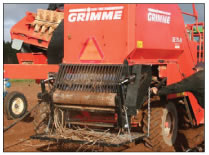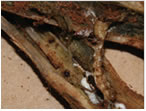A Device to Control European Corn Borers in Potatoes
The European corn borer population has steadily increased over the past ten years and is now causing significant damage to potatoes in Prince Edward Island, New Brunswick, and Nova Scotia. Damage is also on the increase in Quebec. Severe infestations can result in yield reductions as corn borer larvae bore into the stem of the potato plants and feed on the tissue inside, restricting the flow of water and nutrients to the key parts of the growing plant. This insect is very difficult to control because once the larvae hatch and enter the stem they are protected from insecticide sprays.
Agriculture and Agri-Food Canada researchers in Charlottetown have developed a mechanical device to crush potato stems and the larvae of the European corn borer hiding inside when the potatoes are being harvested. Potato growers can use the inexpensive crusher to reduce European corn borer populations and cut down their operating costs by reducing the need to spray their crops as frequently. This project is part of a national strategy to reduce the use of chemical pesticides and develop alternative, reduced-risk pest control options funded through the Pest Management Centre.
European Corn Borer
Adult moths emerge in early to mid-summer and lay their eggs on the stems and the underside of potato leaves. The eggs hatch within a week and the larvae bore into the stem, forming tunnels as they feed on the xylem and phloem tissue within the stem. The entrance holes and tunnels created by the larvae weaken the stem, making it susceptible to wind breakage, acting as entrance points for disease organisms, and also restricting the flow of nutrients. The primary method of controlling this pest is the application of a precisely-timed insecticide aimed at the hatching larvae. However, inclement weather often restricts the precise timing of insecticide applications, resulting in poor control. Once a larva has entered the stem, it is protected from insecticide sprays and is difficult to control. European corn borers overwinter as larvae within the discarded stems of the potato plant following harvest. Control of these overwintering individuals would decrease the colonizing population the following year.
'European Corn Borer Crusher'
Fig. 1. Corn borer crusher.

Researchers at Agriculture and Agri-Food Canada in Charlottetown have developed a device called the 'ECB crusher', to control overwintering European corn borer larvae (Figure 1). The device attaches to the back of a harvester, allowing the grower to simultaneously harvest the tubers and control the European corn borer and eliminate the need to return to the field to control this pest.
Fig. 2. 'ECB crusher' attached to the back of a potato harvester

Description - Fig. 2
Views of the 'ECB Crusher' consisting of two brushes and two metal rollers attached just below the conveyer belt. Two heavy-duty springs at both ends of the roller keep the tension on the rollers and also allow the rollers to open if a rock happens to fall on them. Two motors, visible from behind the rollers, are connected to the hydraulic system of the tractor and keep the rollers turning. Finally a view of the ECB Crusher from the back where the crushed tubers come out from the rollers and are dropped into the field.
The 'ECB Crusher' (Figure 2) consists of two brushes and two metal rollers attached just below the conveyer belt used to discard the potato stalks. Two heavy-duty springs at both ends of the roller keep the tension on the rollers and also allow the rollers to open if a rock happens to fall on them. Two motors, connected to the hydraulic system of the tractor, keep the rollers turning.
Fig. 3. Crushed European corn borer larvae.

As the stalks fall off the belt, they are guided on to and pass through the two rollers before falling to the ground. The tension on the rollers is set to crush the stalks and, in the process, kill/crush the corn borer larvae inside the stalks (Figure 3). A space between the brush and the belt would allow any rocks to fall to the ground, rocks being heavier than the stems, and the bristles of the brush pick up the stems and move them onto the rollers.
The crusher was especially designed so that it could be built to fit different-sized harvesters. All the parts that are needed to build this device can easily be purchased in the length and size required to fit a particular harvester.
Test Results
Efficacy testing: Field trials were conducted in Prince Edward Island on two varieties (cvs Russet Burbank and Kennebec) in 2005. Potato stems were crushed while tubers were harvested. The crushed stems were collected and taken back to the lab where they were split, and all crushed and uncrushed larvae were counted. Results showed between 80-88% of the larvae within the stems were killed (Table 1). Several of the larvae that were not crushed and killed were found to be injured. Although some larvae were alive when the stems were crushed, they might not have survived through the winter months.
| Variety | Russet Burbank % crushed larvae |
Kennebec % crushed larvae |
|---|---|---|
| Test 1 | 79.8 | 87.0 |
| Test 2 | 81.3 | 89.5 |
Moth Emergence: The efficacy of the crusher was also tested by determining how many ECB larvae survive the winter within crushed stems. When stems pass through the crusher they split open, giving greater exposure of any surviving larvae to predators and cold winter temperatures when compared to those larvae within intact stems. Crushed and uncrushed stems from 185 plants for cv. Russet Burbank and 200 plants for cv. Kennebec were collected and placed in the field over the winter months. In early June the crushed and uncrushed stems were collected and placed separately in field cages. The number of moths emerging from these stems was recorded. Results show emergence of 311 and 66 moths from the non-crushed stems, and 3 and 4 moths from the crushed stems, of Russet Burbank and Kennebec respectively. Thus, we found 99% mortality in the crushed Russet Burbank stems and 94% mortality in crushed Kennebec stems when compared to the uncrushed stems (Table 2).
| Non-crushed stems Males |
Non-crushed stems Females |
Crushed stems Males |
Crushed stems Females |
|---|---|---|---|
| 158 | 153 | 0 | 3 |
| 311 | 3 | ||
| 99% mortality | |||
| Non-crushed stems Males |
Non-crushed stems Females |
Crushed stems Males |
Crushed stems Females |
|---|---|---|---|
| 39 | 27 | 4 | 0 |
| 66 | 4 | ||
| 94% mortality | |||
Conclusions
Based on the results obtained we can conclude that the crusher demonstrated a very high efficacy in controlling ECB larvae overwintering within the discarded potato stalks. The flexibility of the design of the crusher makes this device easy to build and attach to any harvester. It also allows a grower to harvest and control the corn borer simultaneously, thus eliminating the need for re-entry into the field to control this insect. Reducing overwintering populations would reduce the colonizing population for the following year, and thus help potato producers to reduce the number of spray applications and operating costs.
Acknowledgements
This work was supported by the Pest Management Centre of Agriculture and Agri-Food Canada, Pesticide Risk Reduction Program.
For further information, contact: Dr. Christine Noronha